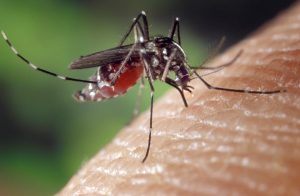27
Jul
Colombia Cautiously Declares End to Mosquito-Borne Zika Epidemic
(Beyond Pesticides, July 27, 2016) In South America, Colombia has officially declared an end to its Zika epidemic. The country, which previously had the highest cases of suspected Zika virus infection after Brazil, with a total of more than 99,721 people infected since September 2015 have registered a drop in the number of infections to 600 new cases a week, down significantly from a peak of more than 6,000 cases a week in February, according to health officials. Fernando Ruíz, M.D., Deputy Minister of Health and Service Provision in Colombia, said the numbers signaled that the epidemic had given way to an endemic phase of the disease, in which it continues to be present but spreads much more slowly.
This news arrives following the publication of Zika Virus Disease in Colombia —Preliminary Report, which suggests that infe
ctions late in pregnancy may pose less risk to the fetus than widely feared. The report follows thousands of women in Colombia who have had symptoms consistent with Zika virus disease during pregnancy to try to better understand the risk the virus poses. At the ti me of the report, the country had only seven official cases of microcephaly, a birth defect marked by small head size, related to Zika infection.
me of the report, the country had only seven official cases of microcephaly, a birth defect marked by small head size, related to Zika infection.
The Zika virus, which is transmitted to people primarily through the bite of an infected Aedes species mosquito (Ae. aegypti and Ae. albopictus), generally causes no symptoms or only mild illness on its own in most healthy adults, but can be more hazardous to pregnant woman, as it has been linked to microcephaly, and Guillain-Barré syndrome, which causes temporary paralysis in adults. Meanwhile, many commonly used mosquito pesticides, such as permethrin, resmethrin, and malathion, are all associated with human and ecological health risks, especially among people with compromised immune systems, chemically sensitized people, pregnant women, and children with respiratory problems, such as asthma.
The Colombian Instituto Nacional de Salud (INS) began official surveillance for Zika in August 2015, and in early October 2015, a Zika outbreak was declared after the first cluster of laboratory-confirmed cases was identified in nine patients from northern Colombia. By April 2, 2016, a total of 11,944 pregnant women with Zika were reported in the country, with 1,484 (12%) of these cases confirmed by means of reverse-transcriptase—polymerase-chain-reaction (RT-PCR) assay. In a subgroup of 1,850 pregnant women, more than 90% of women who were reportedly infected during the third trimester had given birth, and no infants with apparent abnormalities, including microcephaly have been identified.
However, the data are preliminary, cautions Margaret Honein, Ph.D., an epidemiologist at the U.S. Centers for Disease Control and Prevention in Atlanta, one of the authors of the report. “It’s somewhat reassuring” that few severe problems have appeared in the babies born so far, Dr. Honein says, “but this is by no means final.”
Data from other countries have suggested that the virus is most dangerous to a fetus early in pregnancy, so experts warn that Colombia may still face a wave of birth defects in the coming months. In fact, Dr. Ruíz predicts a spike of cases of in September and October, when pregnant women infected during the peak of the epidemic are due to give birth. But, these numbers are still expected to be much lower than initial projections. According to The Guardian, the Colombian government projected it could see some 500-600 cases of Zika-related microcephaly but later revised the projection downward and maintains an estimate of 100-300 cases.
While mosquitoes can pose serious public health threats when they carry diseases like Zika, West Nile virus and others, it’s important to not let fear lead on management approaches, and the decision to risk exposing vulnerable populations to potentially harmful diseases caused by mosquitoes or to chronic or deadly illnesses caused by pesticides.
Many experts agree that an efficient mosquito management strategy emphasizes public awareness, prevention, and monitoring methods. Combating mosquito-borne diseases should include good surveillance and scientific understanding for controlling mosquito populations, including a focus on eliminating or managing breeding areas, utilizing biological controls, exclusion from indoor environments with screening, and repellents. According to Dino Martins, PhD, a Kenyan entomologist, the explosion of mosquitoes in urban areas, which is driving the Zika crisis, is caused by a lack of natural diversity that would otherwise keep mosquito populations under control, and the proliferation of waste and lack of disposal in some areas which provide artificial habitat for breeding mosquitoes.
Beyond Pesticides’ Public Health Mosquito Management Strategy (see also mosquito management strategy summary) is an integrated approach that emphasizes education, aggressive removal of standing water (which are breeding areas), larval control, monitoring, and surveillance for both mosquito-borne illness and pesticide-related illness. Control of disease-carrying mosquitoes can be successful when emphasis is placed on public education and preventive strategies.Community based programs should encourage residents to employ these effective techniques, focus on eliminating breeding sites on public lands, and promote monitoring and action levels in order to determine what, where, and when control measures might be needed. Through education of proper cultural controls, and least-toxic and cost effective biological alternatives, the use of hazardous control methods, such as toxic pesticides, can be eliminated.
Beyond Pesticides’ Mosquito Management program page has a list of resources that can help you and your community safely manage mosquitoes, including least-toxic mosquito repellents, bed nets, and proper clothing that can be used to keep mosquitoes safely at bay.
Sources: The Guardian, Science Magazine
All unattributed positions and opinions in this piece are those of Beyond Pesticides.










